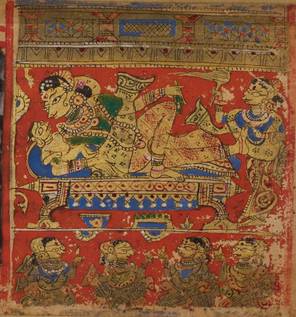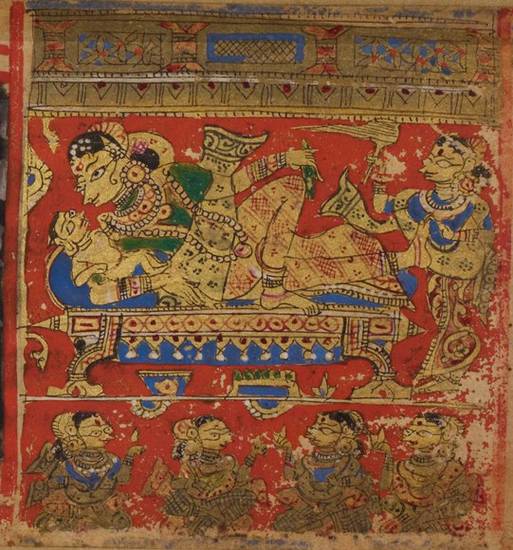Article: Jain Universal History
Western scholars use the term ‘Universal History’ for the narrated history of people in the different known parts of the world and the interconnections among them. In Jain studies, the term refers to the body of work consisting of the biographies of the śalākā-puruṣas or mahā-puruṣas – ‘great men’. In particular, Jain Universal History deals with the lives of the Jinas, the Cakravartins and the nine groups of Baladevas, Vāsudevas and Prati-vāsudevas.
The texts that recount these biographies are generally called purāṇas – ‘ancient [scriptures]’ – or caritras – ‘deeds’. The Jain Purāṇas tell the complete mytho-legendary history of the world for the current time period from a distinct Jain perspective, up to the last historical Jina, Mahāvīra, and his famous early disciples.
The symmetry and repetitiveness that characterises Jain cosmology can be found here too. For example, although these narratives are limited to the present time period, they are representative of the history of other time periods as well, namely the past and future. The lives of many of the great men also show marked similarities, featuring, for instance, prophetic dreams and the interventions of gods and supernatural elements.
Periods of time
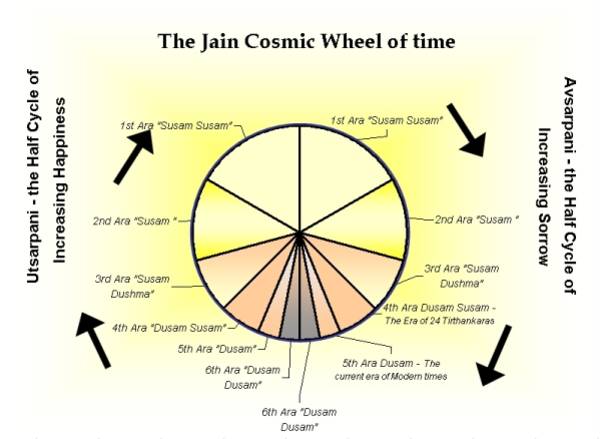
Cycle of time
Image by Anishshah19 © public domain
According to traditional Jain cosmology, the regions where humans live are categorised as karma-bhūmi – ‘land of action’. They are subject to a regular sequence of alternating time periods, called:
- utsarpiṇī – ‘ascending phase’
- avasarpiṇī – ‘descending phase’.
Two of these phases make up one cycle of time. The phases alternate between improving and worsening conditions of life. When human existence is at its climax of development in terms of spirituality, morality, lifespan, stature, knowledge and pleasure, a new avasarpiṇī begins. Conditions gradually begin to deteriorate, until they reach a nadir. Then a new utsarpiṇī starts, in which the conditions gradually improve until a new climax is reached. Each phase is composed of six eras of different lengths.
'Great men'
In practice, what is called Jain Universal History consists of the biographies of specific categories and numbers of heroes and other characters, who are thought to recur in every half-cycle of time. These characters are śalākā-puruṣas or mahā-puruṣas – ‘great men’.
The most frequently used list of 'great men' has 63 characters for every time phase, comprising:
- 24 Jinas
- 12 Cakravartins
- 9 Baladevas
- 9 Vāsudevas
- 9 Prati-vāsudevas.
Other lists exclude the Prati-vāsudevas or include other categories, such as the:
These biographies generally include accounts of several previous existences of each of these mahā-puruṣas and their principal antagonists. These effectively explain what happens to them in their lives as mahā-puruṣas and integrate their stories into the broader frame of Jain karmic theory.
Jinas
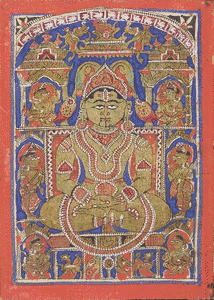
Omniscient Ṛṣabha
Image by Wellcome Trust Library © Wellcome Library, London
The greatest of the mahā-puruṣas are the Tīrthaṃkaras – ‘ford-makers’ – who are also frequently referred to as Jinas – ‘conquerors’. Their life stories in Jain Universal History are often very similar.
The first of the 24 Jinas of the present half-cycle of time is Ṛṣabhanātha or Lord Ṛṣabha, who lived during the suṣamā-duṣamā period. All the others were born in the following period, the duṣamā-suṣamā period, which is the era before the present one.
The Jinas of this avasarpiṇī phase of time all hail from royal families. In one of their earlier existences, their souls bound a specific type of karman, called the tīrthaṃkara-nāma-karman. This forecasts that one becomes a Jina in a future birth.
In ritual and art, the main events in the life of a Jina are reduced to five episodes, the so-called pañca-kalyāṇakas – ‘five auspicious episodes’ of:
- conception – cyavana
- birth – janma
- initiation into monastic life – dīkṣā
- enlightenment – kevala-jñāna
- final liberation – nirvāṇa or mokṣa.
Each of these episodes is accompanied by miraculous elements, such as rains of gems or the attendance of gods and goddesses.
Cakravartins

14 magical jewels
Image by British Library © CC0 1.0 (Creative Commons Public Domain)
The Cakravartin is a ‘universal emperor’, who rules over large parts of the world, typically the six parts of Bhārata-varṣa. In Jain cosmology this is the entire civilised world. They live at different times in every half-cycle of time and their early lives share similarities with those of the Jinas. Cakravartins have various supernatural possessions or associates and have a variety of destinies.
The 12 Cakravartins of the present time period are:
- Bharata
- Sagara
- Maghavan
- Sanatkumāra
- Śānti
- Kunthu
- Ara
- Subhūma or Subhauma
- Mahāpadma or Padma
- Hariṣeṇa
- Jayasena
- Brahmadatta.
Three of these men become Cakravartins – ‘universal emperors’ – before they become Jinas. These are the:
- 16th Jina, Śāntinātha or Lord Śānti
- 17th Jina, Kunthunātha or Lord Kunthu
- 18th Jina, Aranātha or Lord Ara.
In previous existences the Cakravartins gathered a large amount of religious merit, and cultivated a nidāna – an intense desire to become a cakravartin, which is held on to in various incarnations of the soul. Their early lives proceed in a similar way to that of the Jinas, in that they are all born into royal families and their destiny is prophesied by a number of dreams of their pregnant mothers. They grow up to become powerful rulers, subjugating surrounding kingdoms – digvijaya. Eventually, the magic discus – cakra – Sudarśana appears in their armouries and they are then anointed cakravartin, which literally means ‘he who revolves the discus’. They marry many wives and have many sons.
Cakravartins possess:
- 14 ratnas – ‘jewels’ – which are supernatural beings assisting them in their conquest
- 9 nidhis – ‘treasures’ – which contain objects or sciences to facilitate their destiny.
At the end of their lives, some Cakravartins renounce the world and attain omniscience and final liberation. Others become a god in one of the heavens, while still others are reborn in one of the hells.
Baladevas, Vāsudevas and Prati-vāsudevas
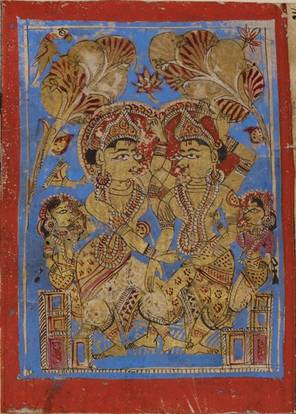
Nemi and Kr̥ṣṇa
Image by British Library © CC0 1.0 (Creative Commons Public Domain)
A Baladeva, Vāsudeva and Prati-vāsudeva always live simultaneously. There are nine sets of them in every half-cycle of time. Bound in a triangle of enmity over many births, these men are popular mythical characters and feature in some of the best-known texts of the Jain Purāṇas. They have close affinities with some figures in Hinduism.
The Baladevas are righteous Jains, who go to heaven or attain liberation at the end of their lives. The Vāsudevas are their younger half-brothers. They kill their arch-enemies, the Prati-vāsudevas, which literally means the ‘anti-Vāsudevas’.
The hostility between the Vāsudeva and Prati-vāsudeva is explained through their encounters in many previous existences. In their lives as mahā-puruṣas the magic discus – cakra – Sudarśana first appears in the armoury of the Prati-vāsudeva, as with the Cakravartin. During the ultimate battle with the Vāsudeva, the Prati-vāsudeva hurls the discus at him. Instead of killing the Vāsudeva, the discus flies into the hands of the Vāsudeva, who throws it at the Prati-vāsudeva and kills him. The Vāsudeva is then hailed as an ardha-cakravartin – ‘half universal emperor’ – and reigns over half of Bhārata-varṣa.
The Jain categories of Baladevas and Vāsudevas, by their very names, are clearly based on the characters who are better known from the Hindu traditions as avatāra – avatars – of the deity Viṣṇu. These are:
- Balarāma, also known as Baladeva
- Kṛṣṇa, also called Vāsudeva, the son of Vasudeva.
The Jains consider these two brothers, Balarāma and Kṛṣṇa, to be the ninth and final Baladeva and Vāsudeva of this time period. They are both popular characters in Jain and Hindu myth. Their enemy, the Prati-vāsudeva, was Jarāsandha, whom Kṛṣṇa eventually vanquishes. The eight preceding Baladevas, Vāsudevas and Prati-vāsudevas are variously named in different sources, shown in this table.
|
|
Baladeva |
Vāsudeva |
Prati-vāsudeva |
|---|---|---|---|
|
1 |
Acala or Vijaya |
Tripṛṣṭa |
Aśvagrīva |
|
2 |
Vijaya or Acala |
Dvipṛṣṭa |
Tāraka |
|
3 |
Bhadra or Dharma |
Svayambhū |
Meraka or Madhu |
|
4 |
Suprabha |
Puruṣottama |
Madhu or Madhusūdana, or Niśumbha or Madhukaiṭabha |
|
5 |
Sudarśana |
Puruṣasiṃha |
Niśumbha or Madhukaiṭabha or Madhukrīḍa |
|
6 |
Ānanda or Nandiṣeṇa or Nandimitra |
Puruṣapuṇḍarīka |
Bali or Niśumbha |
|
7 |
Nandana or Nandiṣeṇa or Nandimitra |
Puruṣadatta or Datta |
Prahlāda or Praharaṇa or Balīndra |
|
8 |
Padma or Rāma |
Lakṣmaṇa or Nārāyaṇa |
Rāvaṇa or Daśānana |
|
9 |
Balarāma or Rāma, or Padma |
Kṛṣṇa |
Jarāsaṃdha |
Many of these also resemble the names of characters from myths associated with the Hindu deity Viṣṇu or one of his avatars, particularly Kṛṣṇa. The Jain Vāsudevas are modelled after the popular description of Kṛṣṇa. With a black-blue complexion, he wears yellow robes and is for ever young and without any facial hair. In addition, in Jain texts he is referred to by popular epithets from the Vaiṣṇava tradition, such as Viṣṇu, Janārdana, Govinda, Nārāyaṇa, Keśava and Mādhava.
Other great men

Figure of Bāhubali
Image by Vikas m © public domain
Other, more extensive lists of Jain 'great men' include further categories of śalākā-puruṣas.
Among these are the 9 Nāradas, named after the divine intriguing musician Nārada, who is well known from the Hindu epics and Purāṇas. The Jain nāradas, who live in succession, are malicious troublemakers who go to hell for their machinations.
The 11 Rudras – ‘dreadful ones’ – are ascetics, living successively, in the monastic order of one of the Jinas. They eventually abandon the path of asceticism and therefore also go to hell.
The Kulakaras – ‘patriarchs’ – vary in number from 7 to 14 or 16. They are born consecutively in the suṣamā-duṣamā period, when people become frightened by the changing conditions in their surroundings. The Kulakaras teach them how to adjust to these conditions and thus provide them with a sense of security. The last of the Kulakaras of this time period was Nābhi, the father of the first Jina, Ṛṣabhanātha or Lord Ṛṣabha.
A popular secondary category of śalākā-puruṣas are the 24 Kāma-devas – ‘love-gods’. Like the pan-Indian god of love, Kāma, they are very handsome and have many wives. The most famous among them is one of the sons of the first Jina, named Bāhubali. Other Kāma-devas are Kṛṣṇa’s father Vasudeva and his son Pradyumna, and characters better known from the Sanskrit epics, such as Hanumān and King Nala, the beloved of Damayantī.
Literary forms
According to tradition, the subject matter of Jain Universal History was narrated in the Pūrvas, a part of the Jain canon which has been lost since the fourth century BCE. Other parts of the Śvetāmbara canon, which is not accepted by the Digambaras in its entirety, contain some information about the lives of the śalākā-puruṣas, especially some Jinas.
The literary genre associated exclusively with Jain Universal History is that of the Jain Purāṇa. This forms a ‘counter tradition’ to the rising popularity of Hindu Puranic religion. Śvetāmbaras often call these compositions caritra – ‘deeds’. The oldest available purāṇa or caritra is the Paümacariya by Vimala-sūri, written in Māhārāṣṭrī Prakrit. It focuses on the lives of the eighth:
- Baladeva – Rāma
- Vāsudeva – Lakṣmaṇa
- Prati-vāsudeva – Rāvaṇa.
In effect, it is a Jain version of the popular Rāmāyaṇa tale. Aside from the story of the Rāmāyaṇa, the Paümacariya also includes the biographies of the first two Jinas, and the first, second and ninth Cakravartins.
The most popular characters from Jain Universal History, as far as literary adaptations are concerned, appear to be those included in compositions generally called Nemi-caritras or Harivaṃśa-purāṇas. These all focus on the lives of the ninth Baladeva, Vāsudeva and Prati-vāsudeva, who are called Balarāma, Kṛṣṇa and Jarāsandha. They also deal with the life of the 22nd Jina, Neminātha or Lord Nemi, who is Kṛṣṇa’s young cousin.
The first complete literary composition of Jain Universal History, often referred to as a mahā-purāṇa – ‘great purāṇa’ – was composed by Śīlāṅka in 868 to 869. This is his Caüppaṇṇa-mahāpurisa-cariya – Deeds of the 54 Great Men. Śīlāṅka does not count the nine Prati-vāsudevas among the śalākā-puruṣas, hence the lower number of 54 instead of 63. Historically, more influential is the Mahā-purāṇa by Jinasena and Guṇabhadra written in the ninth century and the Tri-ṣaṣṭi-śalākā-puruṣa-caritra by Hemacandra, dating from the 12th century.
Finally, one of the books in the Śvetāmbara canon, the Kalpa-sūtra, provides the earliest life stories of the most prominent Jinas, namely:
- Mahāvīra
- Pārśvanātha or Lord Pārśva
- Nemi
- Ṛṣabhanātha or Lord Ṛṣabha.
Reading
- Śīlāṅkas Cauppaṇṇamahāpurisacariya: Ein Beitrag zur Kenntnis der Jaina-Universalgeschichte
Klaus Bruhn - De Gruyter; Hamburg, Germany; 1954
- ‘Repetition in Jaina Narrative Literature’
Klaus Bruhn - Indologica Taurinensia
edited by Nalini Balbir and Colette Caillat
volume 11
International Association of Sanskrit Studies; 1983
- ‘An Overview of the Jaina Purāṇas’
John E. Cort - Purāṇa Perennis: Reciprocity and Transformation in Hindu and Jaina Texts
edited by Wendy Doniger
State University of New York Press; New York, USA; 1993
- Jainism: An Indian Religion of Salvation
Helmuth von Glasenapp - translated by Shridhar B. Shrotri
Lala Sundar Lal Jain Research series; volume 14
Motilal Banarsidass; New Delhi, India; 1999
- ‘Contemplating the Jain Universe: Visions of Order and Chaos’
Phyllis Granoff - Victorious Ones: Jain Images of Perfection
edited by Phyllis Granoff
Mapin Publishing Pvt. Ltd and Rubin Museum of Art, New York; Ahmedabad, Gujarat, India and New York, USA; 2009
- Outlines of Jainism
Jadmanderlal Jaini - edited by F. W. Thomas
Cambridge University Press; Cambridge, UK; 1916
- ‘A Purāṇic Counter Tradition’
Padmanabh S. Jaini - Purāṇa Perennis: Reciprocity and Transformation in Hindu and Jaina Texts
edited by Wendy Doniger
State University of New York Press; New York, USA; 1993
- Jadivasaha’s Tiloya-Paṇṇatti
edited by A. N. Upadhye and Hiralal Jain - Jivaraja Jain Granthamala series; volume 1 and 1.2
Jaina Samskriti Samraksaka Samgha; Sholapur, Maharashtra, India; 1951–1956
- Jainendra Siddhānta Kośa
Jinendra Varṇi - volume 38
Bhāratīya Jñānapītha Publication; New Delhi, India; 2003
Links
- Cakravartin and Jain kingship
-
Google Books provides John Cort's discussion of the concepts of the cakravartin and Jain kingship. Read pages 98 to 99 of this excerpt from Cort's 'Who is a King?' chapter in Open Boundaries 1998.
- Types of ‘Great Men’
-
Information about the types of śalākā-puruṣas or mahā-puruṣas – ‘great men’ – in traditional Jain stories is provided by the Shrimad website. This information is not considered to be correct by scholars but represents a popular contemporary understanding of the categories of the 'great men'.
- Brass statue of Kunthu
-
A 15th-century sculpture featuring the 17th Jina Kunthunātha or Lord Kunthu and other holy figures. A zoomable image of the small metal shrine is provided by the Eastern Art Online: Yousef Jameel Centre for Islamic and Asian Art website, a project of the Ashmolean Museum in Oxford, UK.
- Kunthunātha altarpiece
-
The Norton Simon Museum in Pasadena, California, provides a zoomable photograph of a small altarpiece featuring the 17th Jina, Kunthunātha or Lord Kunthu. The metal figure is surrounded by his retinue of divine attendants and symbols of royalty, such as the parasol. Sitting in meditation, he displays typical indications of advanced spirituality, such as elongated earlobes and the bump of wisdom on his head.
http://www.nortonsimon.org/collections/browse_title.php?id=M.2010.1.51.S
- Pārśva and multiple Jinas
-
The Norton Simon Museum in California provides a zoomable photograph of a metal altarpiece featuring the 23rd Jina Pārśvanātha or Lord Pārśva. Surrounded by the symbols and divine attendants who form the entourage of the Jina image – parikara – Pārśva is presented against a background of many other Jinas, all sitting in deep meditation.
http://www.nortonsimon.org/collections/browse_title.php?id=F.1975.17.22.S
- Parents of a Jina
-
Stone relief of the parents of a Jina. This somewhat damaged sculpture comes from Gwalior, Madhya Pradesh, and shows a richly bejewelled king and queen with attendants. The Metropolitan Museum of Art in New York, USA, provides this black and white photograph.
http://www.metmuseum.org/Collections/search-the-collections/60005089
- Jina’s parents
-
The Asian Art Museum in San Francisco, USA, provides a photograph of a sculpture of the parents of a Jain teacher or Jina. From Uttar Pradesh, this stele was carved in the tenth century CE.
http://searchcollection.asianart.org/view/objects/asitem/nid/11263
- Lord Nemi and his retinue
-
Bronze shrine featuring the 22nd Jina, Nemi, and attendants. Attributes of high status are clear, such as the triple canopy, the lion throne and the servants. His spiritual supremacy is signalled by the nimbus around his head, his lotus pose of meditation, the śrīvatsa on his chest and the meditating Jinas on both sides. At the bottom on either side sit his male attendant deity – yakṣa – Gomedha and his female attendant deity – yakṣī – Ambikā. This zoomable photograph is on the website of the Norton Simon Museum in Pasadena, California, USA.
http://www.nortonsimon.org/collections/browse_title.php?id=F.1975.17.23.S
- R̥ṣabha and Indra
-
A manuscript painting in the Los Angeles County Museum of Art shows Indra, king of the gods, taking the infant R̥ṣabhanātha or Lord R̥ṣabha, the first Jina, to Mount Meru for his ritual bath. The decorated elephant and canopy symbolise royalty while the lotus flowers are emblems of spiritual purity. The gods around blow trumpets and conches in celebration. A very popular Jain hymn of praise, the Bhaktāmara-stotra has been translated into many languages and illustrated numerous times.
- +
- aAbhavya
- aAbhinandana
- aAbhiṣeka
- aĀcāra
- aĀcārāṅga-sūtra
- aĀcārya
- aAchalbhrata
- aAḍhāī-dvīpa
- aAdharma
- aAdho-loka
- aAdhyayana
- aAdvaita Vedānta
- aĀgama
- aAghātīya
- aAghātīya-karman
- aAgnibhuti
- aAgra
- aĀhāra
- aAhiṃsā
- aAhimsa Day
- aAjita
- aAjīva
- aAkampit
- aĀkāśa
- aAkbar the Great
- aAkṣaya-tṛtīyā
- aAlauddin Khalji
- aAlbert Einstein
- aAllah
- aAlms
- aĀlocanā
- aAloka-ākāśa
- aAmāri
- aAmbikā or Kūṣmāṇḍinī
- aAnagāra
- aAnanta
- aAnarthadaṇḍa
- aAnaśana
- aAnekānta-vāda
- aAṅga
- aAniconism
- aAnojjā
- aAntarāla
- aAntarāya-karma
- aAṇu
- aAṇu-vrata
- aAnukampā
- aAnuprekṣā
- aAnusvāra
- aApabhraṃśa
- aAparigraha
- aAra
- aĀrambha
- aĀrambhaja
- aĀratī
- aArdhamāgadhī Prākrit
- aArhaṃ
- aArhat
- aArśana-āvaraṇīya-karma
- aĀrta-dhyāna
- aĀryikā
- aĀryikā Jñānamati
- aĀśātanā
- aĀścarya
- aAscetic
- aAsceticism
- aAshram
- aAspiration
- aĀsrava
- aAṣṭa-maṅgala
- aAṣṭāpada
- aAstikāya
- aAstrolabe
- aAsura
- aAtheism
- aAticāra
- aAtiśayakṣetra
- aAtithisaṃvibhāgavrata
- aĀtma-vāda
- aĀtman
- aAuṃ
- aAurangzeb
- aAuspicious
- aAusterity
- aAvadhāna
- aAvadhi-jñāna
- aĀvaraṇī-yakarman
- aAvasarpiṇī
- aAvatāra
- aAvidyā
- aAxiom
- aĀyāga-paṭa
- aĀyambil
- aĀyu-karma
- aĀyurveda
- bBabur
- bBāhubali
- bBaladeva
- bBālāvabodha
- bBandha
- bBasadi
- bBazaar
- bBhadrankarvijay
- bBhagavant
- bBhaktāmara-stotra
- bBhakti
- bBhale
- bBharata
- bBhāṣā
- bBhāṣya
- bBhaṭṭāraka
- bBhāva
- bBhāva-pūjā
- bBhāvanā
- bBhavana-vāsin
- bBhavya
- bBhavyatva
- bBhaya
- bBhoga-bhūmi
- bBhogopabhoga
- bBodhi
- bBollywood
- bBrahmā
- bBrahma-deva
- bBrahmacārī
- bBrāhmaṇa
- bBraj Bhāṣā
- bBright fortnight
- bBritish Raj
- bBuddha
- bBuddhi-sagar
- bBuddhism
- bBuddhist
- cCaitya
- cCaityavāsin
- cCakravartin
- cCakreśvarī
- cCāmara
- cCandanā
- cCandragupta
- cCandraprabha
- cCanon
- cCāritra
- cCāritramohanīya-karman
- cCarũrī
- cCaste
- cCaturvidha-saṅgha
- cCaturviṃśati-stava
- cCāturyāma
- cCE
- cCelibacy
- cCha
- cChadmastha
- cChastity
- cCheda-sūtra
- cChristian
- cChristianity
- cClergy
- cCloning
- cColophon
- cCommentary
- cConch
- cConfession
- cCongregation
- cConsecration
- cCosmology
- cCremation
- cCrore
- cCult
- cCūrṇi
- dDādā-guru
- dDalit
- dDāna
- dDaṇḍa
- dDark fortnight
- dDarśana
- dDarśanamohanī-yakarman
- dDaśa-lakṣaṇa-parvan
- dDeity
- dDelhi Sultanate
- dDerāsar
- dDeśāvakāśika-vrata
- dDetachment
- dDevanāgarī
- dDevānandā
- dDevarddhi-gani
- dDevotee
- dDhamal
- dDhanuṣ
- dDhāra
- dDharma
- dDharma-dhyāna
- dDharma-sāgara
- dDharmastikaya
- dDhātakīkhaṇḍa
- dDholak
- dDhyāna
- dDiaspora
- dDig-vrata
- dDigambara
- dDīkṣā
- dDisciple
- dDīvālī
- dDivya-dhvani
- dDNA
- dDoctrine
- dDogma
- dDonor
- dDoṣa
- dDravya
- dDravya-pūjā
- dDrone
- dDuṣamā
- dDuṣamā-duṣamā
- dDuṣamā-suṣamā
- dDveṣa
- dDvīpa
- eEast India Company
- eEightfold Path
- eEkānta-vāda
- eEkendriya
- eElder
- eElders
- eEschatology
- eEtc up to
- fFarmān
- fFast
- fFatehpur Sikri
- fFestival
- fFestschrift
- fFiruz Shah
- fFly-Whisks
- fFolio
- fFour Noble Truths
- gGaccha
- gGaṇa
- gGaṇadhara
- gGanadharavada
- gGaṇeśa
- gGaṇin
- gGarba
- gGarbha
- gGarbha-gṛha
- gGaruḍa
- gGati
- gGene
- gGenomics
- gGhātī-yakarman
- gGhātīya
- gGhaznavid
- gGhiyasuddin Tughlaq
- gGhurid
- gGloss
- gGotra-karma
- gGujarāt
- gGujarati
- gGuṇa
- gGuṇa-sthāna
- gGuṇa-vrata
- gGupti
- gGuru
- gGuruṇī
- hHagiography
- hHajj
- hHaṃsa
- hHaribhadra
- hHariṇaigameṣin
- hHasta
- hHeresy
- hHiṃsā
- hHindi
- hHindu
- hHinduism
- hHīravijaya
- hHoroscope
- hHrīṃ
- hHumayun
- hHymn
- iIconoclasm
- iIconography
- iIdol
- iIndian Independence
- iIndology
- iIndra
- iIndrabhūti Gautama
- iIndriya
- iInitiation
- iIntercession
- iInvocation
- iIQ
- iIslam
- iIslamicate
- iIṣṭadevatā
- iĪśvara
- jJagat
- jJahangir
- jJain
- jJaina Devanāgarī
- jJaina Śaurasenī
- jJaina-dharma
- jJainaśāsana
- jJainness
- jJaisalmer
- jJamāli
- jJambū-dvīpa
- jJames Burgess
- jJanma
- jJanma-kalyāṇa
- jJarā
- jJāti
- jJina
- jJina-āgama
- jJina-bhavana
- jJina-bimba
- jJina-mātā
- jJinacandra-sūri
- jJinadatta
- jJinaprabha
- jJīva
- jJñāna
- jJñāna-āvaraṇīya-karma
- jJñāna-āvarṇiya
- jJñānsundar
- jJyotiṣka
- kKāla
- kKālakācārya-kathā
- kKālidāsa
- kKalpa-sūtra
- kKalpa-vṛkṣa
- kKalyāṇaka
- kKalyanvijay
- kKamaṇḍalu
- kKamaṭha
- kKarma
- kKarma-bhūmi
- kKarma-grantha
- kKarma-prakṛti
- kKarma-vāda
- kKarmon
- kKarnataka
- kKaṣāya
- kKathā
- kKāvya
- kKāya
- kKāyotsarga
- kKeśa-loca
- kKetu
- kKevala-jñāna
- kKevalin
- kKhalji
- kKharatara-gaccha
- kKnowledge
- kKriyā
- kKriyā-vāda
- kKṛṣṇa
- kKṣamā-śramaṇa
- kKṣapakaśreṇi
- kKṣatriya
- kKṣullaka
- kKulakara
- kKundakunda
- kKunthu
- lLabdhi
- lLaity
- lLakh
- lLāñchana
- lLands of Action
- lLaukāntika
- lLavaṇa-samudra
- lLeśyā
- lLiṅga
- lLinguistics
- lLoka
- lLoka-ākāśa
- lLoka-puruṣa
- lLoka-vāda
- lLotus
- lLotus lake
- mMadhya-loka
- mMahā-videha
- mMahā-vrata
- mMahābhārata
- mMahāmastakābhiṣeka
- mMāhārāṣṭra
- mMāhārāṣṭrī Prākrit
- mMahattarā Yākinī
- mMahāvīr Jayantī
- mMahāvīra
- mMakāra
- mMakkhali Gośāla
- mMalli
- mMāna-stambha
- mManaḥ-paryāya-jñāna
- mMaṇḍala
- mMaṇḍapa
- mMandit
- mMaṅgala
- mMantra
- mMantras
- mManuṣya-loka
- mMarāṭhī
- mMārgaṇā
- mMartyr
- mMarudevī
- mMaṭha
- mMati-jñāna
- mMauryaputra
- mMecca
- mMendicant lineage
- mMetarya
- mMiracle
- mMithyādṛṣṭi
- mMohandas Gandhi
- mMohanīya-karma
- mMokṣa
- mMonastic order
- mMonasticism
- mMonk
- mMonotheism
- mMosque
- mMount Meru
- mMount Sammeta
- mMṛgāvatī
- mMughal
- mMuhammad
- mMuhammad bin Tughlaq
- mMuhpattī
- mMūla-sūtra
- mMūlaguṇa
- mMumbaī
- mMuni
- mMunisuvrata
- mMurad Bakhsh
- mMūrti-pūjaka
- mMuslim
- mMysticism
- nNābhi
- nNāga-kal
- nNāgapurīya Tapā-gaccha
- nNāgarī
- nNāma-karma
- nNamaskāra-mantra
- nNami
- nNandīśvara-dvīpa
- nNandivardhana
- nNandyāvarta
- nNāraka
- nNāraki
- nNasalisation
- nNātha
- nNavrātrī
- nNaya-vāda
- nNemi
- nNidāna
- nniggaṃthāṇa vā 2
- nniggaṃtho vā 2
- nNigoda
- nNihnava
- nNikṣepa
- nNirgrantha
- nNirjarā
- nNirvāṇa
- nNiryukti
- nNiṣidhi
- nNitya
- nNiyati
- nNo-kaṣāya
- nNudity
- nNun
- oOcean of milk
- oOmniscience
- oOrdination
- ppa°
- pPadmaprabha
- pPadmāsana
- pPadmāvatī
- pPādukā
- pPalanquin
- pPalette
- pPañca-muṣṭi
- pPāṇḍava
- pPaṇḍit
- pPandit Dalsukh D. Malvania
- pPandit Sukhlalji
- pPāṇipātra
- pPāpa
- pParamātman
- pParameṣṭhin
- pPāraṇā
- pParigraha
- pPariṇāma
- pParīṣaha
- pParokṣa
- pPārśva
- pPārśvanātha
- pParyāya
- pParyuṣaṇ
- pPaṭa
- pPatan
- pPātra
- pPenance
- pPersian
- pPhala
- pPhilology
- pPicchikā
- pPilgrimage
- pPīr
- pPolymath
- pPoṣadha
- pPossession
- pPothī
- pPrabhas
- pPradakṣiṇā
- pPradeśa
- pPrākāra
- pPrakīrṇaka-sūtra
- pPrākrit
- pPramāda
- pPramukhā
- pPrati-vāsudeva
- pPratikramaṇa
- pPratimā
- pPratiṣṭhā
- pPratyākhyāna
- pPratyakṣa
- pPravacana
- pPrāyaścitta
- pPrayer
- pPre-modern
- pPreach
- pPredestination
- pProtestant
- pProvenance
- pPudgala
- pPūjā
- pPujārī
- pPukharavara-dvīpa
- pPuṇya
- pPūrva
- pPuṣkara-dvīpa
- pPuṣpadanta
- pPyre
- qQur’an
- rRāga
- rRāhu
- rRainy season
- rRajasthan
- rRajasthani
- rRājimatī
- rRajoharaṇa
- rRajput
- rRāma
- rRāmāyaṇa
- rRangoli
- rRās-garbā
- rRasa
- rRathanemi
- rRatna-traya
- rRātri-bhojana
- rRaudra-dhyāna
- rRecto
- rRelic
- rRenunciation
- rRetroflex
- rRevatī
- %Ṛg-veda
- rRite
- rRosary
- %Ṛṣabha
- %Ṛṣabhanātha
- rRupee
- sSaciyā Mātā
- sSādhu
- sSādhvī
- sSāgāra
- sSaint
- sŚaivaism
- sŚaka-saṃvat
- sSallekhanā
- sŚalya
- sSamacatuṣṭha
- sSamādhimaraṇa
- sSamaṇi
- sSāmarambha
- sSamavasaraṇa
- sSāmāyika
- sSaṃbhava
- sSamiti
- sSaṃjñā
- sSaṃkalpaja
- sSaṃsāra
- sSamudghāta
- sSaṃvara
- sSaṃvega
- sSamyak-cāritra
- sSamyak-darśana
- sSamyak-jñāna
- sSamyaktva
- sSaṃyama
- sSanctuary
- sSandalwood
- sSaṇgha
- sSanskrit
- sSant
- sŚānti
- sSapta-bhaṅgi-naya
- sSārambha
- sSarasvatī
- sSarvajña
- sSāsan-devi
- sŚāsana-devatā
- sŚāstra
- %Ṣaṭ-jīvanikāya
- sSatī
- sSatīmātā
- sSatya
- sSchism
- sScribe
- sScripture
- sSect
- sSecularism
- sŚenāī
- sSermon
- sŚeṣavatī
- sSevā
- sSeven fields of donation
- sShah Jahan
- sShantidas Jhaveri
- sShrine
- sSiddha
- sSiddha-śilā
- sSiddhacakra or Navadevatā
- sSiddhānta
- sSiddhārtha
- sSiddhi
- sSikh
- sSikhism
- sŚikṣā-vrata
- sŚīla
- sSin
- sSindh
- sŚītala
- sŚiva
- sSkandha
- sSomanatha
- sŚraddhā
- sŚramaṇa
- sŚrāvaka
- sŚrāvakācāra
- sŚrāvikā
- sŚreyāṃsa
- sŚrī
- sŚrīvatsa
- sŚruta-jñāna
- sŚruta-pañcamī
- sSthānaka-vāsin
- sSthāpanācārya
- sSthāvara
- sSthavira
- sSthiti
- sStrīmukti
- sStūpa
- sSubcontinent
- sSudarshana
- sŚuddhi
- sSudharma
- sŚūdra
- sSufism
- sSukha
- sŚukla-dhyāna
- sSulasā
- sSultan
- sSumati
- sSundarśrī
- sSupārśva
- sSūri
- sSuṣamā
- sSuṣamā-duṣamā
- sSuṣamā-suṣamā
- sSūtra
- sSuyam me ausam! Tenam bhagavaya evamakkhayam
- sSvādhyāya
- sSvāhā
- sSvastika
- sŚvetāmbara
- sŚvetāmbara Terāpanthin
- sŚvetāmbaras
- sSwan
- sSyād-vāda
- tTabla
- tTantra
- tTapā-gaccha
- tTapas
- tTāraṇ Svāmī Panth
- tTattva
- tTattvārtha-sūtra
- tTemple
- tTemple-city
- tThe Enlightenment
- tTheology
- tThree worlds
- %Ṭīkā
- tTilaka
- tTīrtha
- tTīrthaṃkaranāma-karman
- tTīrthankara
- tTransliteration
- tTrasa
- tTrasa-nāḍī
- tTriśalā
- tTriṣaṣṭi-śalākā-puruṣa-caritra
- tTti bemi
- tTughlaq
- tTunk
- uUdumbara
- uUniversal History
- uUpādhyāya
- uUpāṅga
- uUpaniṣads
- uUpāsaka
- uUpasarga
- uUpāśraya
- uŪrdhva-loka
- uUtsarpiṇī
- uUttarādhyayana-sūtra
- vVāhana
- vVaimānika
- vVairāgya
- vVaiṣṇava
- vVaiśramaṇa
- vVaiśya
- vValabhī
- vVanaspatikāya
- vVandana
- vVaṇik
- vVarṇa
- vVāsudeva
- vVāsupūjya
- vVayubhūti
- vVeda
- vVedanīya-karma
- vVegetarianism
- vVehicle
- vVernacular
- vVerso
- vVidyā
- vVidyā-devī
- vVihāra
- vVijñapti-patra
- vVikrama-saṃvat
- vVikṛti
- vVimala
- vVinaya
- vVipāka
- vVirji Vora
- vVirodhaja
- vVīrya
- vVisarga
- vViṣṇu
- vVītarāga
- vVizier
- vVotive
- vVow
- vVrata
- vVS
- vVyakta
- vVyantara
- vVyasana
- yYakṣa
- yYakṣī
- yYantra
- yYaśoda
- yYaśovijaya
- yYati
- yYātrā
- yYoga
- yYoginī
- yYojana


